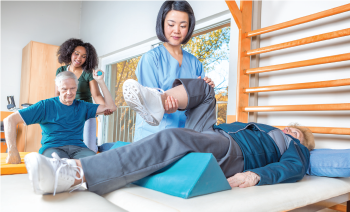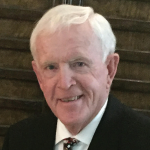
Syda Productions / shutterstock.com
Kim Steinbarger, PT, MHS, knows how physical and occupational therapy can make a difference for patients with rheumatic diseases. Ms. Steinbarger was just two years into her career as a physical therapist (PT) when she was diagnosed with rheumatoid arthritis (RA) in 1991.
“I’ve seen how regular exercise serves as an important tool in managing rheumatic disease, making muscles stronger and joints more flexible,” says Ms. Steinbarger, director of clinical education at Husson University’s School of Physical Therapy in Bangor, Maine. She credits her own exercise regimen, including tae kwon do, with helping her maintain functionality.
Ms. Steinbarger is one of many PTs across the country who work with rheumatologists as part of a multi-disciplinary team. Despite advances with new targeted therapeutics, research has shown physical therapy can help patients with rheumatic diseases better cope with pain and inflammation. In addition, PTs work closely with occupational therapists (OTs) who teach rheumatology patients ways to improve their overall daily function.

Ms. Steinbarger
For patients who struggle to complete daily living tasks or have significant impairments in strength, range of motion and balance issues, PTs and OTs can work with rheumatologists to offer patients both pain relief and an improved quality of life. In some cases, such as knee osteoarthritis, research has shown physical therapy can help delay knee replacement surgery.
“PTs and OTs are an integral part of the rheumatology team and can help with patient education, pain management and mobility,” says Robert Richardson, PT, MEd, FAPTA, a physical therapist at Maria Parham Health, Henderson, N.C. “Rheumatologists often only have a limited amount of time with patients, but PTs and OTs can supplement that with half-hour to 45-minute appointments and provide an extra level of care through physical therapy sessions and a home exercise regimen.”
The Rheumatologist recently spoke with Mr. Richardson, former president of the ARHP (now the Association of Rheumatology Professionals [ARP]), as well as other PTs and OTs, to determine how rheumatologists can better utilize both professions in their practice and work together to provide better patient outcomes.
Teach Patients to Self-Manage
For patients with a rheumatic disease that limits their activities, PTs and OTs can complement traditional medical care by identifying treatments that help patients maintain function and quality of life. As part of her doctoral dissertation, Ms. Steinbarger is working to develop a program that would teach self-management skills to patients newly diagnosed with autoimmune diseases, particularly those with RA.
“Although it can seem counterintuitive to patients with arthritis, one of the most important things they can do is move,” Ms. Steinbarger says. “Starting an exercise regimen, such as swimming, walking or yoga, can improve strength, prevent muscle loss, improve balance and benefit their overall health.”
Often, Ms. Steinbarger works with an OT to help patients make modifications that make their life easier.

Mr. Richardson
“If a patient is having a problem with arthritis in their hands, we’ll talk about how to make their home more RA friendly by using soap dispensers with pumps or kitchen gadgets, such as a mezzaluna,” Ms. Steinbarger says. “This device features wooden handles on each end and a rocking motion that makes cutting vegetables and meats easier.”
Carole Dodge, OTRL, CHT, a clinical supervisor and supervisor of the occupational hand therapy program at Michigan Medicine in Ann Arbor, agrees it’s worthwhile for rheumatologists to refer all newly diagnosed patients to a PT and OT.
“In addition to teaching them ways they can take control of their disease and how to live with a chronic illness, we can connect them with important community resources, such as the Arthritis Foundation,” says Ms. Dodge, who is also an ARP member. “We also discuss any activities patients may be avoiding because of their disease and how we can help.”
Ms. Dodge also recommends rheumatology patients return to an OT/PT if there has been a change in their condition, such as joint inflammation that lasts longer than two weeks.
‘Although it can seem counterintuitive to patients with arthritis, one of the most important things they can do is move.’ —Ms. Steinbarger
Align Your Practice with a PT/OT
Danille Parker, PT, MPT, DPT, GCS, CEEAA, a clinical associate professor and director of clinical education in Marquette University’s Physical Therapy Department, Milwaukee, Wis., says PTs and OTs should be included as part of every rheumatology team.

Ms. Dodge
“Both PTs and OTs are trained to help with patient education, pain management and mobility concerns,” Dr. Parker says. “We can monitor and adjust [therapy] over time based on how each patient responds and how their disease progresses.”
Dr. Parker believes it’s important for patients to be referred to a PT and OT upon their initial diagnosis and at least once a year for a progress assessment.
“We want to ensure patients are staying active, so if they have experienced changes in their condition, we can offer exercise modifications or suggestions for devices to improve their quality of life,” Dr. Parker says.
For rheumatologists who don’t have a PT or OT affiliated with their practice, Ms. Steinbarger says there is value in contracting with local professionals who might offer patient consultations at a rheumatologist’s practice on a monthly basis.
If this isn’t possible, Ms. Dodge recommends rheumatologists align themselves with a PT and OT in their community who has experience working with patients who have rheumatic diseases.
“A lot of PTs and OTs have experience working with patients who have sustained a sports injury or have been in an accident,” Ms. Dodge says. “Working with patients who have a chronic rheumatic disease can be very different.”
Design an Appropriate Exercise Regimen

Ms. Parker
Although patients with arthritis may think regular exercise seems counterintuitive and might increase their pain, Dr. Parker says the reality is inactivity leads to increased joint pain and stiffness.
“There’s a lot of evidence behind exercise treatment plans for rheumatic conditions,” Dr. Parker says. “We know activity initiated at a low level of intensity progressing to moderate intensity can help prevent the progression of arthritis and improve overall fitness.”
A PT can work with a patient to develop an exercise regimen that’s both safe and effective, and that reflects the patient’s disease and disability level.
“If a patient reports increased pain at the gym, it might be because they’re using poor posture or are pushing too hard,” Dr. Parker says. “In that case, we might work on their posture and modify the duration and intensity of their workouts.”
Mr. Richardson says the specific exercises PTs teach patients are designed to address mobility problems, protect joints and help them reclaim their lives rather than give up completely on activities they once enjoyed.
“If a patient wants to improve upper body strength but can no longer hold hand weights, we might suggest resistance bands or medicine balls,” Mr. Richardson says. “Our goal is to limit pain while increasing strength and endurance.”
According to Mr. Richardson, all rheumatic patients can benefit from physical and occupational therapy. Over the years, he’s had many patients who believed living with pain was inevitable.
“If a patient is suffering from knee pain, we’re going to look at how strong the muscles are that support the knee as well as the patient’s hip muscles and core,” Mr. Richardson says. “With a plan that includes PT sessions and a regular home daily exercise program, I’ve seen many patients reduce pain, gain strength and increase their mobility.”
In addition, Mr. Richardson works to get patients to avoid sitting or inactivity for long periods of time. And because safety is paramount, he says PTs can also educate a patient’s family by teaching them important tasks, such as how to safely transfer their loved one in or out of a chair or bed.
Ensure Proper Splinting & Support
Ms. Dodge says patients with arthritis often benefit from custom-fitting orthoses or supports that can ease the stress on painful joints. Rather than having patients purchase orthotics or supports on their own, Ms. Dodge says there’s value in seeing an OT.
“Often people will get an orthotic that’s ill-fitting or the wrong size, and this can make their pain and mobility worse,” Ms. Dodge says. “An OT can ensure they have the right orthotic for stabilization.”
In addition, Ms. Dodge says when meeting with new patients, she assesses their condition and conducts tests to determine how well they can open jars, turn keys and fasten clothing. She then offers advice on joint protection and assistive devices, giving them tools to manage their symptoms and decrease pain.
“Based on how well they do, I might suggest making adjustments in technique or using a device,” Ms. Dodge says. “If they are having problems getting dressed, there are sock aids and button hooks that can help make the process easier.”
Products that can make a patient’s life easier don’t need to be costly, and Ms. Dodge says she can work within a patient’s budget. And because fatigue can also be common in those with rheumatic diseases, Ms. Steinbarger says she addresses this with patients.
“I talk to patients about conserving their energy and often refer to the Spoon Theory by blogger Christine Miserandino,” Ms. Steinbarger says. “Counting spoons serves as a metaphor for calculating your energy when you have a chronic illness. You start the day with a number of spoons and each spoon represents a burst of energy, so patients learn to live life at a slower pace and conserve their energy.”
Linda Childers is a health writer located in the San Francisco Bay Area.



